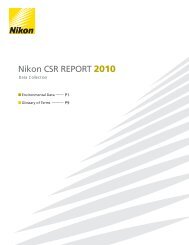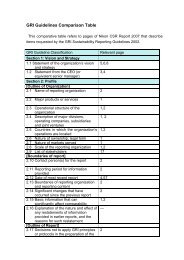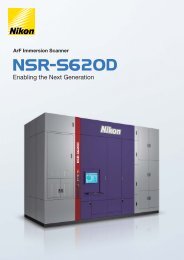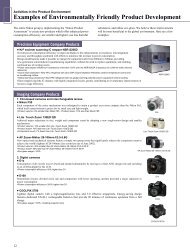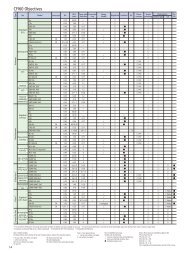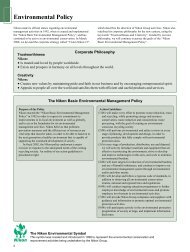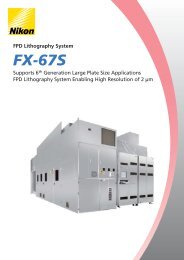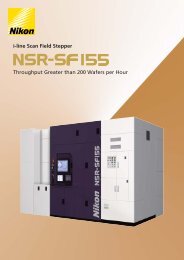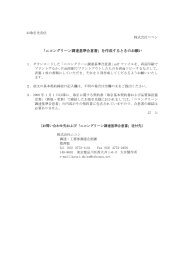Control of Chemical Substances - Nikon
Control of Chemical Substances - Nikon
Control of Chemical Substances - Nikon
You also want an ePaper? Increase the reach of your titles
YUMPU automatically turns print PDFs into web optimized ePapers that Google loves.
Activities in the Workplace Environment<br />
<strong>Control</strong> <strong>of</strong> <strong>Chemical</strong> <strong>Substances</strong><br />
<strong>Chemical</strong> substances have the potential to improve our lives in<br />
many ways, but at the same time can cause many serious problems<br />
such as ozone layer depletion, dioxin poisoning <strong>of</strong> earth and water,<br />
and the environmental endocrine effect — the spread <strong>of</strong> harmful<br />
elements throughout nature. In order to forestall this sort <strong>of</strong> damage,<br />
Substance <strong>Control</strong> Procedures<br />
<strong>Nikon</strong> performs chemical substance control at every phase <strong>of</strong> the<br />
product life cycle, from purchase through use and disposal, in order<br />
to stop pollution caused by these substances. When first purchasing<br />
a new chemical substance, we obtain a Material Safety Data Sheet<br />
(MSDS) for the item, and carry out an assessment <strong>of</strong> the potential<br />
dangers <strong>of</strong> its use in the workplace. Based on the results <strong>of</strong> this<br />
it is vital that the use <strong>of</strong> chemical substances be carefully controlled,<br />
that the amount <strong>of</strong> chemicals used is reduced, and that safer<br />
substances are substituted wherever possible.<br />
<strong>Nikon</strong> is currently devising a management system that will<br />
enable us to effectively take all <strong>of</strong> these actions.<br />
assessment, our Environment, Safety and Hygienics section<br />
performs a review and confirmation <strong>of</strong> actions taken.<br />
In addition to these measures, our Data Centre, located at the<br />
Ohi Plant, carries out intensive management <strong>of</strong> registration, updates<br />
and storage <strong>of</strong> MSDS.<br />
The process <strong>of</strong> obtaining MSDS and the purchasing <strong>of</strong> new chemical substances<br />
Obtaining MSDS<br />
Place <strong>of</strong> use<br />
Requests MSDS using<br />
“MSDS Request Form”<br />
New purchasing arrangements<br />
Place <strong>of</strong> use<br />
Creates “Dangerous or Harmful Substance Use Report”<br />
Prior consideration<br />
Safety and Hygienics Group<br />
Exists<br />
Checks for<br />
existing MSDS<br />
(relevant workplace)<br />
Does not exist<br />
Reconsideration<br />
NO<br />
NO<br />
OK<br />
Environment, Safety and<br />
Hygienics Group<br />
Check<br />
(Relevant workplace)<br />
OK<br />
Place <strong>of</strong> use<br />
Store MSDS<br />
Data Centre<br />
Place <strong>of</strong> use<br />
Exists<br />
Checks for<br />
existing MSDS<br />
Does not exist<br />
4. Forward<br />
1. “Material<br />
Request Form”<br />
Procurement Group<br />
3. Delivery 2. Order<br />
Safety and Hygienics Group<br />
Stores and<br />
forwards MSDS<br />
Procurement Group<br />
Requests MSDS<br />
Receives MSDS<br />
Supplier<br />
(manufacturer etc.)<br />
Place <strong>of</strong> use<br />
Stores MSDS<br />
Data Centre<br />
Stores and<br />
forwards MSDS<br />
Safety and Hygienics Group<br />
Stores and<br />
forwards<br />
MSDS<br />
Place <strong>of</strong> use<br />
Stores MSDS<br />
Proceed with new purchasing arrangements<br />
18
Targets<br />
• Reduce use <strong>of</strong> chlorinated organic solvents in wash by at least 70% in fiscal 2003,<br />
with goal <strong>of</strong> elimination <strong>of</strong> these solvents by end <strong>of</strong> fiscal 2006.<br />
<strong>Nikon</strong>’s PRTR<br />
The Pollutant Release and Transfer Register (PRTR) Law has been<br />
enacted in Japan as well, and daily management <strong>of</strong> chemical<br />
substances and diligent risk management are key factors in<br />
promoting business.<br />
The “<strong>Nikon</strong> PRTR Guide” was released in March 2000, and<br />
management activity for the specified chemical substances is<br />
underway at each plant. This guide serves as a<br />
safety management standard which clearly<br />
outlines handling and disposal according to<br />
MSDS, for all product phases from<br />
procurement to use and disposal.<br />
PRTR Survey Results for fiscal 2001<br />
Ohi Plant<br />
Yokohama Plant<br />
Sagamihara Plant<br />
Kumagaya Plant<br />
Total<br />
Facility<br />
Substance<br />
No.<br />
144<br />
145<br />
145<br />
145<br />
230<br />
304<br />
145<br />
200<br />
227<br />
144<br />
145<br />
200<br />
227<br />
230<br />
304<br />
Dichloropenta fluoropropane<br />
Dichloromethane<br />
Dichloromethane<br />
Dichloromethane<br />
Lead and lead compounds<br />
Boron and boron compounds<br />
Dichloromethane<br />
Tetrachloroethylene<br />
Toluene<br />
Dichloropenta fluoropropane<br />
Dichloromethane<br />
Tetrachloroethylene<br />
Toluene<br />
Substance name<br />
Lead and lead compounds<br />
Boron and boron compounds<br />
Volume<br />
handled<br />
1.32<br />
1.11<br />
6.35<br />
10.98<br />
9.69<br />
11.19<br />
3.79<br />
1.00<br />
2.54<br />
1.32<br />
22.22<br />
1.00<br />
2.54<br />
9.69<br />
11.19<br />
1.08<br />
0.75<br />
6.27<br />
9.52<br />
0.01<br />
0.01<br />
3.79<br />
1.00<br />
1.64<br />
1.08<br />
20.32<br />
1.00<br />
1.64<br />
0.01<br />
0.01<br />
Amount released<br />
Air Public water Soil Sewage<br />
0.00<br />
0.00<br />
0.00<br />
0.00<br />
0.00<br />
0.00<br />
0.00<br />
0.00<br />
0.00<br />
0.00<br />
0.00<br />
0.00<br />
0.00<br />
0.00<br />
0.00<br />
0.00<br />
0.00<br />
0.00<br />
0.00<br />
0.00<br />
0.00<br />
0.00<br />
0.00<br />
0.00<br />
0.00<br />
0.00<br />
0.00<br />
0.00<br />
0.00<br />
0.00<br />
Amount transferred<br />
0.00<br />
0.00<br />
0.00<br />
0.00<br />
0.00<br />
0.00<br />
0.00<br />
0.00<br />
0.00<br />
0.00<br />
0.00<br />
0.00<br />
0.00<br />
0.00<br />
0.00<br />
Waste<br />
0.24<br />
0.00<br />
0.08<br />
1.46<br />
5.70<br />
6.57<br />
0.00<br />
0.00<br />
0.00<br />
0.24<br />
1.54<br />
0.00<br />
0.00<br />
5.70<br />
6.57<br />
<strong>Nikon</strong> PRTR Guide<br />
Amount<br />
in on-site<br />
landfill<br />
0.00<br />
0.00<br />
0.00<br />
0.00<br />
0.00<br />
0.00<br />
0.00<br />
0.00<br />
0.00<br />
0.00<br />
0.00<br />
0.00<br />
0.00<br />
0.00<br />
0.00<br />
Amount<br />
removed for<br />
processing<br />
0.00<br />
0.00<br />
0.00<br />
0.00<br />
0.00<br />
0.00<br />
0.00<br />
0.00<br />
0.00<br />
0.00<br />
0.00<br />
0.00<br />
0.00<br />
0.00<br />
0.00<br />
Unit: tons/year<br />
Amount<br />
shipped<br />
in product<br />
* The above table includes data only for specified substances <strong>of</strong> which one or more tons are handled per year per facility. No such substances exist at the Mito Plant.<br />
* Waste transferred includes tonnage transferred <strong>of</strong>f-site for disposal or processing, as well as for free or fee-based recycling.<br />
* Amount removed for processing indicates change in substance due to neutralization, decomposition or reactive processing on-site.<br />
* Amount shipped in product indicates tonnage shipped from the site in or accompanying products (finished and semi-finished products). Tonnages sold to external firms for recycling or eliminated through chemical processing are also<br />
included.<br />
* PRTR<br />
The Pollutant Release and Transfer Register (PRTR) is a framework for registering and publicly announcing transfer tonnages for harmful chemical substances, either released into the environment or transferred as waste for proper<br />
disposal. The appropriate government agency tracks, compiles and announces release tonnages (air, water, soil) and transfer tonnages (waste) for specified substances, based on enterprise reports and statistics.<br />
In Japan, the PRTR became law on July 13, 1999, and it applied beginning with reports submitted during the year starting April 2001 with a notification date <strong>of</strong> April 2002 or later.<br />
0.00<br />
0.36<br />
0.00<br />
0.00<br />
3.99<br />
4.61<br />
0.00<br />
0.00<br />
0.90<br />
0.00<br />
0.36<br />
0.00<br />
0.90<br />
3.99<br />
4.61<br />
Reduction in <strong>Chemical</strong> <strong>Substances</strong><br />
The key question is how to best reduce the amount <strong>of</strong> chemical<br />
substances used. This is more than merely avoiding the risk <strong>of</strong><br />
environmental pollution, and in fact signifies an improvement in<br />
<strong>Nikon</strong>’s design and production systems. We are constantly working<br />
to reduce the volume <strong>of</strong> chemical substances used which have the<br />
most adverse effects on the environment, searching for alternates,<br />
and making every effort to achieve zero chemical pollution.<br />
1) CFC elimination<br />
CFCs have been cited as one <strong>of</strong> the key factors in the deterioration<br />
<strong>of</strong> the ozone layer. <strong>Nikon</strong> established the “CFC Countermeasures<br />
Committee” in December 1988, and totally eliminated CFC usage<br />
in May 1994, well in advance <strong>of</strong> the December 1994 goal<br />
established in the “Montreal Protocol”.<br />
2) Efforts to eliminate chlorinated organic solvents<br />
We have established a target for total elimination <strong>of</strong> chlorinated<br />
organic solvents in wash applications <strong>of</strong> the end <strong>of</strong> fiscal 2006, and<br />
are now switching over to hydrocarbon wash agents and similar<br />
substances that have minimal effect on the environment. In fiscal<br />
2001, usage was reduced by 37% from fiscal 1999 levels.<br />
A lens wash finishing system using IPA (isopropyl alcohol) instead <strong>of</strong> CFCs<br />
19
Activities in the Workplace Environment<br />
Prevention <strong>of</strong> Pollution and Protection <strong>of</strong> Air and Water<br />
To help preserve air and water quality, <strong>Nikon</strong> not only observes<br />
applicable laws and regulations, but has also established its own<br />
independent plant standards for management.<br />
Each plant regularly measures pollutants released into the air<br />
and water, and inspects equipment such as boilers and waste-water<br />
processing systems periodically to ensure safety.<br />
* 2<br />
1. Location 2. Establishment 3. Number <strong>of</strong> employees 4. Outline<br />
(As <strong>of</strong> March 31, 2001)<br />
1. Nishi-Ohi, Shinagawa-ku, Tokyo 2. February 1, 1918<br />
Ohi Plant<br />
3. 1,462 4. Development <strong>of</strong> basic technology, development and design <strong>of</strong> Imaging Company products, etc.<br />
Air (Air Pollution <strong>Control</strong> Law)<br />
Unit: Dust: g/Nm 3 , NOx (nitrous oxides): ppm Water Quality (Sewerage Regulations)<br />
Unit: mg/l, except for pH<br />
Item<br />
Established<br />
standard<br />
Plant standard Actual (max.)<br />
Item<br />
Established<br />
standard<br />
Plant standard Actual (max.)<br />
Dust<br />
0.3<br />
0.3<br />
0.28<br />
0.28<br />
0.003<br />
0.002<br />
pH<br />
BOD<br />
5.8-8.6<br />
300.0<br />
5.9-8.5<br />
285.0<br />
6.3-8.6 * 1<br />
129.3<br />
Boiler<br />
0.15<br />
0.14<br />
0.002<br />
SS<br />
300.0 285.0 1,316.2<br />
46<br />
42<br />
45 * 1 Iodine demand<br />
220.0<br />
200.0<br />
53.3<br />
NOx<br />
250<br />
250<br />
150<br />
225<br />
225<br />
135<br />
85<br />
82<br />
38<br />
n-hexane (animal/vegetable)<br />
Iodine demand<br />
Copper<br />
30.0<br />
220.0<br />
3.0<br />
28.0<br />
209.0<br />
2.8<br />
10.4<br />
119.4<br />
0.1<br />
*1 Occurred May 2000 (exceeded plant standards)<br />
Cause: Drainage <strong>of</strong> concrete wash water from construction site<br />
Corrective action: Enforced observation <strong>of</strong> environmental checklist for on-site construction<br />
*2 Occurred July 2000 (violated established standard)<br />
Cause: Inspection and measurement failed to determine cause; thought to be due to foreign material<br />
present in original test sample<br />
Corrective action: Soil emplaced around tank<br />
Zinc<br />
Soluble iron<br />
Total chrome<br />
Fluorine<br />
Nitrogen<br />
Phosphorous<br />
Cyanide<br />
Lead<br />
Hexavalent chrome<br />
Trichloroethylene<br />
Dichloromethane<br />
5.0<br />
10.0<br />
2.0<br />
15.0<br />
120.0<br />
16.0<br />
1.0<br />
0.1<br />
0.5<br />
0.3<br />
0.2<br />
4.7<br />
9.5<br />
1.9<br />
14.2<br />
114.0<br />
15.0<br />
0.95<br />
0.09<br />
0.47<br />
0.28<br />
0.19<br />
1.4<br />
7.5<br />
1.2<br />
2.2<br />
60.2<br />
3.2<br />
0.2<br />
0.08<br />
0.0<br />
0.00<br />
0.00<br />
1. Nagaodai-machi, Sakae-ku, Yokohama, Kanagawa 2. June 9, 1967<br />
Yokohama Plant<br />
3. 813 4. Development, design and manufacture <strong>of</strong> Instruments Company products, and LCD steppers<br />
Air (Air Pollution <strong>Control</strong> Law, Prefectural Regulations) Unit: NOx (nitrous oxides): ppm Water Quality (Sewerage Law)<br />
Unit: mg/l, except for pH<br />
Item<br />
Established<br />
standard<br />
Plant standard Actual (max.)<br />
Item<br />
Established<br />
standard Plant standard Actual (max.)<br />
65<br />
60<br />
40<br />
pH<br />
5.0-9.0 5.5-8.5 6.6-7.5<br />
65<br />
60<br />
55<br />
COD<br />
600.0<br />
540.0<br />
0.0<br />
Boiler NO<br />
65<br />
60<br />
34<br />
SS<br />
600.0<br />
540.0<br />
0.0<br />
46<br />
42<br />
26<br />
n-hexane (mineral)<br />
5.0<br />
4.5<br />
1.2<br />
46<br />
42<br />
32<br />
Copper<br />
1.0<br />
0.9<br />
0.0<br />
*1 Occurred February 2001 (exceeded plant standards)<br />
Cause: Improper low-NOx burner adjustment<br />
Corrective action: Adjusted to 41 ppm; adjustment and measurement frequency increased to four times/year<br />
Zinc<br />
Soluble iron<br />
1.0<br />
3.0<br />
0.9<br />
1.0<br />
0.0<br />
0.0<br />
Soluble manganese<br />
1.0<br />
0.9<br />
0.0<br />
Total chrome<br />
2.0<br />
1.0<br />
0.0<br />
Nickel<br />
1.0<br />
0.9<br />
0.0<br />
Fluorine<br />
15.0<br />
13.0<br />
1.2<br />
Nitrogen<br />
240.0<br />
135.0<br />
2.5<br />
Phosphorous<br />
32.0<br />
18.0<br />
2.50<br />
Lead<br />
0.1<br />
0.1<br />
0.02<br />
Arsenic<br />
0.1<br />
0.1<br />
0.00<br />
Hexavalent chrome<br />
0.5<br />
0.4<br />
0.00<br />
Trichloroethylene<br />
0.3<br />
0.2<br />
0.00<br />
Tetrachloroethylene<br />
0.1<br />
0.1<br />
0.00<br />
Dichloromethane<br />
0.2<br />
0.1<br />
0.01<br />
Air and Water Quality Environmental Data for Fiscal 2001<br />
Living environment<br />
Health<br />
Health Living environment<br />
20<br />
* For explanations <strong>of</strong> terms such as ppm and pH, see glossary on page 22.
Sagamihara Plant<br />
Unit: Dust: g/Nm 3 ,<br />
Air (Air Pollution <strong>Control</strong> Law, Prefectural Regulations) NOx (nitrous oxides): ppm<br />
Item<br />
Established<br />
standard Plant standard Actual (max.)<br />
Boiler<br />
Dust<br />
NOx<br />
0.15<br />
0.15<br />
0.15<br />
0.15<br />
0.15<br />
0.15<br />
0.15<br />
0.15<br />
105<br />
105<br />
105<br />
105<br />
105<br />
105<br />
105<br />
105<br />
1. Asamizodai, Sagamihara, Kanagawa 2. July 5, 1971<br />
3. 533 4. Manufacture <strong>of</strong> optical glass, R&D <strong>of</strong> lenses<br />
0.1<br />
0.1<br />
0.1<br />
0.1<br />
0.1<br />
0.1<br />
0.1<br />
0.1<br />
100<br />
100<br />
100<br />
100<br />
100<br />
100<br />
100<br />
100<br />
0.0015<br />
0.0019<br />
0.0023<br />
0.0019<br />
0.0021<br />
0.0015<br />
0.0015<br />
0.005<br />
85<br />
95<br />
83<br />
89<br />
89<br />
6<br />
3<br />
Mito Plant<br />
1. Motoishikawa-cho, Mito, Ibaraki 2. January 21, 1991<br />
3. 290 4. Development <strong>of</strong> manufacturing technology, production <strong>of</strong> customised products<br />
Unit: Dust: g/Nm 3 ,<br />
NOx (nitrous oxides): ppm,<br />
Air (Air Pollution <strong>Control</strong> Law, Prefectural Regulations) SOx (sulfurous oxides): Nm 3 /h<br />
Item<br />
Established<br />
standard<br />
Plant standard Actual (max.)<br />
0.3<br />
0.27<br />
0.015<br />
Boiler<br />
Dust<br />
NOx<br />
SOx<br />
0.3<br />
0.3<br />
180<br />
180<br />
180<br />
3.25<br />
3.25<br />
3.25<br />
0.27<br />
0.27<br />
162<br />
162<br />
162<br />
0.67<br />
0.67<br />
0.67<br />
0.031<br />
0.026<br />
67<br />
71<br />
87<br />
0.083<br />
0.031<br />
0.13<br />
Water Quality (Water Pollution <strong>Control</strong> Law) Unit: mg/l, except for pH and E. coli (colonies/ml)<br />
Item<br />
Established<br />
standard<br />
Plant standard Actual (max.)<br />
Living environment<br />
Health<br />
pH<br />
BOD<br />
SS<br />
n-hexane (animal/vegetable)<br />
E. coli (daily average)<br />
Nitrogen<br />
Phosphorous<br />
Trichloroethylene<br />
5.8-8.6<br />
160.0<br />
200.0<br />
30.0<br />
3,000.0<br />
120.0<br />
16.0<br />
0.3<br />
6.0-8.2<br />
20.0<br />
30.0<br />
10.0<br />
2,700.0<br />
60.0<br />
8.0<br />
0.3<br />
6.3-7.8<br />
15.0<br />
12.0<br />
1.8<br />
82.0<br />
57.8<br />
6.39<br />



